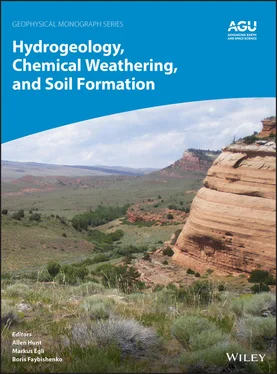1 ...7 8 9 11 12 13 ...17 At the time of its inception, the idea of a soil catena had a mixed reception, but it was generally hailed a valuable, if radical, idea. Its radicality stemmed from Milne’s contention that soils of the bottomlands are as important as soils on the ridges and his conclusion, shared by Sergei Neustruev (1915) before him, that soil‐climatic zones comprise zonal complexes rather than zonal soil types. At the time, it was mainly the well‐drained soils of a region that were singled out as characteristic zonal soil types and displayed on maps; the ill‐drained soils in valley bottoms were demoted to intrazonal status (see Gennadiyev & Bockheim, 2006).
The catena concept was embellished by Thomas M. Bushnell (1942, 1946), who also identified precedents to it, though the term catena was assuredly first adopted by Milne. Bushnell (1942) argued that differences in soil drainage classes along a catena create a hydrological sequence, which suggestion led eventually to the idea of the soil association in USA’s Soil Survey. Some researchers believe that Bushnell narrowed the catena concept to slopes on which all soils have formed in the same parent material; however, that was only the case for his “simple catenas,” in which all soil‐forming factors were the same except for drainage conditions; in his “multiple catenas,” soil‐forming factors, including parent material, could vary. Even so, Bushnell’s emphasis on catenas as hydrological soil sequences did lead to the playing down of the role of slope‐influenced transport and depositional processes that had been held previously as important to the explanation of soil development along slopes (cf. Schaetzl, 2013, 146). Indeed, David Brown (2006, 79) went as far as to say, ‘The U.S. soil survey community distorted and confused Milne’s catena, and only through the work of Robert Ruhe in the 1950s and 1960s,” which re‐energized thinking about connections and interactions between soils and hillslope processes, “was the concept saved from scientific obscurity.”
Topography was one of Jenny’s state factors of soil formation, and he termed variations in soil properties due to topography a toposequence (a contraction of topographical sequence). Unfortunately, partly owing to Bushnell, confusion surrounds the words toposequence and catena . Technically speaking, a toposequence involves variations of soils and soil properties in relation to topography (a state factor) with all other state factors held constant, which means that parent material should be uniform along the sequence; that would make a toposequence equivalent to Bushnell’s narrower definition of a catena. Jenny (1980, 280) suggested that a catena runs from crest to crest across an intervening valley, with the sequence from crest to valley bottom (what he called a half catena) being a toposequence (on uniform parent material). It seems helpful to use catena as originally defined by Milne and distinguish it from toposequence , where slope properties vary but parent material and all other state factors are constant.
Back in Africa, a potent development that underscored the connection between hillslope soils and hillslope hydrology came from Cecil Morison (Morison et al., 1948; Morison, 1949), then at the Department of Agriculture, University of Oxford. Morison and his colleagues went on several expeditions to the Anglo‐Egyptian Sudan to investigate the soil–vegetation units. Preliminary work suggested that the catena concept could be usefully adopted as a framework of study in this area. He found it helpful to distinguish three zones (he termed them complexes) along a catena, each associated with a broad topographic site: the eluvial zone, the colluvial zone, and the illuvial zone. The eluvial zone is a high‐level site that loses water and soluble and suspended matter. Material washed from it is used to build up the colluvial and illuvial zones. The colluvial zone occupies slope sites. It receives material from soils in the eluvial zone and loses some of it to the illuvial zone. The illuvial zone occupies low‐level sites. In many cases it has very mixed parentage, consisting of either a simple mosaic or else a mosaic of zoned patterns, depending upon the amount and nature of drainage. It has three distinguishing characteristics: it receives more water than the climatic normal site, it receives much dissolved and suspended matter, and water is lost from it by surface movement, by drainage, or by evaporation.
Interestingly, at around the same time as Milne proposed the soil catena, Boris B. Polynov put forward the notion of geochemical landscapes. Polynov believed in the integrity of the landscape in producing, transporting, and removing rock debris. Two ideas were central to his thesis: first, that there are three basic landscape types relevant to chemical migration and second, that each chemical has a characteristic mobility in the landscape (Polynov, 1935, 1937). His basic landscape types were eluvial, superaqual, and aqual. In eluvial landscapes, the water table is always, or nearly always, below the ground surface; in superaqual landscapes, the water table and the ground surface coincide; in aqual landscapes, free water rests on the land surface as in lakes. From Polynov’s pioneering studies have evolved several conceptual schemes of geochemical landscapes. Notable contributions have come from Mariya A. Glazovskaya (1963, 1968).
During the 1960s, researchers started to take up Milne’s and Morison’s seminal ideas and investigate soil evolution in the context of hillslopes. Indeed, Vance T. Holliday (2006) argued that Milne’s unique contribution was actually in his linking of soil–catenary patterns to specific slope‐related processes: wetness, solute transport, and erosion and deposition. A consensus grew that soils on lower slopes are potential sumps for the drainage of soils upslope of them (Hallsworth, 1965); that, on hilly terrain, water movement connects soils with one another and differentiates their properties (Blume, 1968); and that adjacent soils at different elevations are linked by a lateral migration of chemical elements to form a single geochemical landscape (Glazovskaya, 1968). A key point in this work is that solution and water transport act selectively so that, as vertical movement in soil profiles produces A and B horizons, the lateral concatenation of soils leads to a differentiation of soil materials along a slope: hill‐top soils are analogues of A horizons, and the valley‐bottom soils are analogues of B horizons (Blume & Schlichting, 1965; Sommer & Schlichting, 1997). Subsequently, the burgeoning sophistication of hillslope hydrological investigations has prompted increasingly detailed and revealing examinations of slope soils using statistical models (e.g. Brown et al., 2004; Brillante et al., 2017) and deterministic models (e.g. Heimsath et al., 1997; Minasny & McBratney, 1999; Yoo et al., 2007; Wackett et al., 2018), although researchers now tend to extend their analysis to the third dimension and consider soil landscapes.
Soil catenas are two‐dimensional transects along hillslopes. They form part of a geomorphic system, the flows of material and energy within which are characteristically three‐dimensional. In moving down slopes, weathering products tend to move at right angles to land‐surface contours. Flowlines of material converge and diverge according to the curvature of contours. The pattern of vergency influences the amounts of water, solutes, colloids, and clastic sediments held in store at different landscape positions. Of course, the movement of weathering products alters the topography, which in turn influences the movement of the weathering products; there is feedback between the two systems.
As soil evolution takes place within a three‐dimensional mantle of material, the spatial pattern of many soil properties will reflect the three‐dimensional topography of the land surface. Indeed, according to the concept of soil‐landscape systems, the dispersion of all the debris of weathering, solids, colloids, and solutes, is, in a general and basic way, influenced hugely by land surface (and phreatic surface) form and organized in three dimensions within the framework imposed by the drainage network (Huggett, 1975).
Читать дальше












